
Late 1500s drawing of a Virginia Native carrying fish by John White: (Church 1975) |
Basket and Bag Weaving in the Northeast |

Late 1500s drawing of a Virginia Native carrying fish by John White: (Church 1975) |
Basket and Bag Weaving in the Northeast |
European documents dating to the 17th century refer frequently to woven baskets and bags of Native Americans. All groups of Native Americans in the northeast had some construct of basketry, birch bark containers being perhaps the most common expression (Ritzenthaler & Ritzenthaler 1970: 79-80). Early historic European accounts often do not distinguish between rigid baskets and the flexible bags of the Native Americans. All types of woven containers, in fact, may have been generically referred to, by European observers, as "baskets" despite differences in the materials or construction techniques employed. It is wise to keep in mind while reviewing early historic accounts, that even though, today, we generally tend to think of "baskets" as rigid splint-woven containers, 400 years ago the term "basket" more aptly referred to any open container, including flexible bags and folded birch bark vessels.
Woven Baskets
Early historic European accounts generally describe baskets in the context of a wigwam, or buried baskets storing foodstuffs for later use by Native Americans. In 1643 Roger Williams (1973: 121) remarks of a Narragansett Wigwam that "In steed of shelves, they have severall baskets, wherein they put all their householdstuffe." In the northeast, storage baskets were constructed from a variety of materials including hemp, rushes or bents, maize husks, silk (or sweet) grass, tree bark, and conceivably even horse-shoe crab shells (Gookin 1970: 16; citing Mourt in Heath 1986: 29; de Rasieres 1967: 107, 108).
Gookin remarks in 1674: From the tree where the bark grows, they make several sorts of baskets, great and small. Some will hold four bushels, or more; and so downward to a pint. In their baskets they put their provisions. Some of their baskets are made of rushes; some, of bents; others, of maize husks; others, a kind of silk grass; others, of a kind of wild hemp; and some, of barks of trees; many of them, very neat and artificial, with the portraitures of birds, beats, fishes and flowers, upon them in colors. [Gookin 1970: 16]
Early historic accounts in New England indicate variable sizes and shapes for woven storage baskets (citing Mourt in Heath 1986: 22, 29; Wood 1865: 107-108). Some quite small as Wood (1865: 107-108) indicates in 1634, "these baskets be of all sizes from a quart to a quarter, in which they carry their luggage", and other baskets larger as Mourt (in Heath 1986: 22) describes in 1622, "with some thirty-six goodly ears of corn, some yellow, and some red, and others mixed with blue, which was a very goodly sight."
European colonists like Mourt in 1622 were very intrigued with the colors and designs applied or woven into baskets (in Heath 1986: 22, 29). Basket materials were generally dyed before they were woven together, and in weaving the strands together, a design was produced. In other cases the colored designs are embroidered onto the surface of a basket after it was constructed. Mourt (in Heath 1986: 29), in 1622, mentions colors of black and white. Red wool is used in a Narragansett twined basket (Simmons: 1978: 192). Josselyn's (in Lindholdt 1988: 101-102) narrative from the 1600's refers to several colors (black, blue, red and yellow) used to dye and decorate baskets, bags and mats as well as to dye porcupine quills used in bag weaving. Gookin (1970: 16) describes designs of ëbirds, beasts, fishes and flowers in colors placed upon basketsí in his collections from 1674. The baskets mentioned in these accounts seem to refer to more realistic animal and floral designs (Gookin 1970: 16; Wood 1865: 107), unlike the surviving Mohegan and Narragansett twined bags from the 17th century (Simmons: 1978: 192).
Baskets were often used to store food which was harvested by the Native Americans and then put up for later use. In 1622, Mourt (in Heath 1986: 22, 29, 34, 65) makes numerous references to the contents of these storage baskets, including but surely not limited to: corn, roasted crab, fishes, pieces of fish (including broiled herring and other dried shell fish) and parched acorns.
Another container worthy of mention was apparently a small basket for parched corn meal to be used as an instant food reserve while traveling (Gookin 1970: 15). Roger Williams (1973: 100) writes in 1643: "I have travelled with neere 200. of them at once, neere 100. miles through the woods, every man carrying a little Basket of this [Nokehick] at his back, and sometimes in a hollow Leather Girdle about his middle, sufficient for a man three or foure daies." Earlier in 1634, William Wood (1865: 76) notes that meals of parched corn while traveling consisted of "thrice three spoonefuls a day, dividing it into three meales." This figure of nine spoonfuls a day for three or four days, suggests this basket must have held one or two cups of corn meal.
Wicker-type baskets are also mentioned by Ritzenthaler & Ritzenthaler (1970: 79-80) in their report of the Great Lakes Region. In this area wicker baskets were constructed (though to a limited degree) of willow stems, cedar roots, or basswood bark. A form of wicker baskets may also have been woven by more southerly tribes, indicated in a 1500's drawing by John White (Church 1975: 93), showing North Carolina Native Americans cooking fish. One of the Native Americans portrayed in this drawing carries a twined basket on his back that may be similar to the wicker baskets referred to by Ritzenthaler & Ritzenthaler (1970: 79-80).
Woven Bags
Native Americans in 17th century New England wove bags for carrying and storing items. Josselyn (in Lindholdt 1988: 93) remarks in 1674 that Natives used these bags or sacks to store corn powder, "which they make use of when stormie weather or the like will not suffer them to look out for their food." Roger Williams (1973: 121) suggests in 1643 that these bags were impressively large: "they have some great bags or sacks made of Hempe, which will hold five or sixe bushells". Woven hemp bags (likely made of dogbane, Apocynum cannabinum, also called ëIndian Hempí) are also mentioned by de Vries (1967: 219) between 1633 and 1655, "and the savages use a kind of hemp, which they understand making up, much stronger than ours is, and for every purpose, such as notassen, (which are their sacks, and in which they carry everything);". De Vries (1967: 219) also notes that Native Americans made a "linen" out of hemp.
In addition to tightly woven storage and carrying bags, European accounts from northern New England indicate that open-weave rectangular bags, hulling bags, and bags made of corn husk were also woven (Anonymous 1967: 301; Ritzenthaler & Ritzenthaler 1970: 76). Slightly different techniques were used to weave these bags. In making thse rectangular basswood bags, a "pair of twisted basswood cords were twined around one or two warp strands in rows about a half inch apart" (Ritzenthaler & Ritzenthaler 1970: 76). In 1650, a European account of New Netherland describes that when purchasing corn from the Native Americans with wampum, the corn was often measured in sacks most likely made from husks (Anonymous 1967: 301).
Two examples of 17th century hemp and basswood bags have survived the years intact. The bags are small storage bags which were probably used to hold corn powder (Nohicake) or other household supplies. Both bags are made using a two-strand twined weft method, but the materials and decorative techniques used are different.
Sections of 17th century bags have also been found by William Simmons (1970: 97), an archaeologist in southern New England. At the West Ferry cemetery, two adult Narragansett women were found buried with bast textile fragments identified as "plain twine weave". On fragment consisted of warp that was loose and braided while the weft of the textile was a two-strand sloping cord. This fragment may be the remains of an open weave bag (Simmons 1970: 97).
Splint Work and Basket Stamping:
Historians argue whether or not prepared ash splint basketry was practiced by the Pequot, Mohegan, Niantic and other tribes of southern New England in 1600. Many maintain that this splint basketry was introduced later in the historic period by Swedes on the Delaware River (citing Brasser in Snow 1980: 58). The materials used in Native splint basketry include brown (or black) ash and white oak (Speck 1915: 2). Sweet grass (often braided first), and in much later historic times twisted Hong Kong grass, were sometimes woven over ash splints warps. Two types of splint baskets were historically woven by Native Americans in southern New England, checker-work and a round "gizzard" or mellon-shaped basket generally made of oak (Speck 1915: 3).
"The introduction of typographic ornamentation in the basketry had its beginning among Indian converts of New England in the zone of influence radiating from John Eliot's mission stations active between 1650 and 1658. The experience gained by the Indian converts who printed the Natick Bible (1664) can be considered in retrospect as the source of a stimulus in figure printing, diffusing from the whites to semi-acculturated Indians of eastern Massachusetts" (Speck 1947: 33).
Despite the almost exclusive confinement of block-stamp decoration to splint basketry in the late historic period, Speck (1947: 33) indicates: "The use of block stamps as mediums of designing arose in some center of the Eastern Woodlands culture area of the United States as an independent feature of native decorative art."
Another ornamental feature of splint basketry which seems to preserve earlier forms of aboriginal art is the Schagticoke use of the 'curlicue' or porcupine twist. "The curlicue consists of a splint run over one of the warp splints and twisted between two alternate standards, thus making a sort of twisted imbrications" (Speck 1915: 6). The Schagticoke associate the embellishment with the form of a shell and claim the technique to be a native feature and, since it is found in the oldest baskets from the region, there seems little doubt that it is aboriginal in origin (Speck 1915: 6).
In 1674, Gookin (1970: 16) describes a large storage basket which had a capacity of at least four bushels. Mourt (in Heath 1986: 22) also describes a very large storage basket containing ears of corn: "The basket was round, and narrow at the top; it held about three or four bushels, which was as much as two of us could lift up from the ground, and was handsomely and cunningly made." This large basket may be similar in shape to a smaller bell-shaped Seneca salt or tobacco bottle of plain twined corn husks depicted by Turnbaugh and Turnbaugh (1986: 128-129)
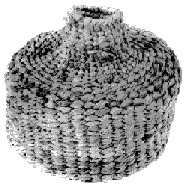
Twined cornhusk bottle
Turnbaugh & Turnbaugh 1986
Gookin (1970: 15) refers to another kind of basket woven during the 17th century, a sieve or sifting basket for corn meal. Speck (1915: 55) illustrates what may be a similar hexagonal-weave basket. De Vries (1967: 218), between 1633 and 1655, likened these sifting baskets to European fig-baskets: "When they travel, they take a flat stone, and pound it with another stone placed upon the first, and when it is pounded, they have little baskets, which they call notassen, and which are made of a kind of hemp, the same as fig-baskets- which they make so neatly that they serve them as sieves- and thus make their meal."
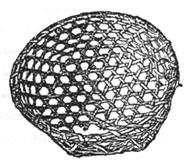
Sifting Basket
Speck 1915
Coil baskets also appear to be a traditional basket form of tribes of northern New England. It is likely that coil baskets were made by the Native Americans of southern New England in the 17th century as well. Ritzenthaler & Ritzenthaler (1970: 79-80) describe the manufacture of coil baskets of sweet grass, Torresia ordorata Hitchc, being sewn with a fiber thread. The only implement required would be a bone awl to open a hole for passage of the thread, which was passed around the free coil and beneath the fastened coil below. A central north Algonquin coiled sweet grass basket of the Patowatomi is illustrated in Turnbaugh and Turnbaugh (1986: 132-133).
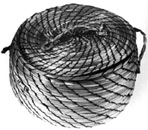
Potawatomi coiled
sweetgrass basket
Turnbaugh & Turnbaugh 1986
Twined bags also made of prepared basswood and other bast-fiber string including nettle fiber. Woven bags of the Chippewa, Menomini, Potawatomi, and Winnebago are illustrated in Ritzenthaler & Ritzenthaler work (1970: Pl. 31), and in Coeís work (1986: 68-69, 95) which illustrates a contemporary bast hemp bag made by Narragansett Ella Seketau. Bags using the checker-weave technique were also woven of basswood and cedar strips (Ritzenthaler & Ritzenthaler 1970: 76). In an illustration of Penobscot hunting in 1911, a father wears a checker-woven basswood hunting bag with a burden strap (Speck 1976: 84).

Penobscot man with
basswood hunting bag
Speck 1976
More often than not, the weaving of storage and carrying bags employed the twining technique. A bag was started with a warp suspended over a string between two thick, springy sticks set vertically in the ground (Ritzenthaler & Ritzenthaler 1970: 76, Pl. 31). The weft was of a pair of cords which twined around each warp, and twining proceeded downward, until the bag was finished (Ritzenthaler & Ritzenthaler 1970: 76). In the Penobscotsí fine weaving, strips of basswood are drawn between the thumb and a round smooth bone or stone about six inches long to soften the strips (Speck 1976: 135).
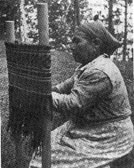
Yarn bag weaving
Chippewa
Ritzenthaler & Ritzenthaler 1970
Bags used for hulling corn were evidently woven of cedar bark in a open, twine weave. Turnbaugh and Turnbaugh (1986: 118) illustrate a later open-twined, diverted warp (or zig-zag) beach grass bag made by a Gay Head Wampanoag of Massachusetts. The Gay Head bag may have been similar to the older hulling bags. These hulling bags were used by New England Native Americans to hold corn while it was being soaked for cleansing (Ritzenthaler & Ritzenthaler 1970: 76).
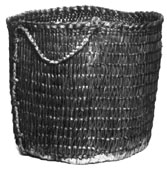
Wamapanoag bag
Open twined zigzag warp
Turnbaugh & Turnbaugh 1986
Of their descriptions of the arts of Native Americans of the Lakes Region, Ritzenthaler and Ritzenthaler (1970: 76) describe some common decorative motifs incorporated into their designs: "On the earlier bags, rows of zoomorphic designs were not unusual. Thunderbirds, spirits in panther form, as well as humans, were interspersed with bands of geometrical motifs." Ritzenthaler & Ritzenthaler (1970: 76) also point out: "On more recent bags, the designs show a concentration of bands of floral and geometrical patterns."
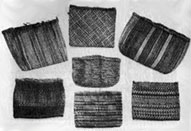
Woven bags of
Menomini, Chippewa & Potawatomi
Ritzenthaler & Ritzenthaler 1970
The Mohegan twined bag dates from the mid-17th century, and uses 'Indian hemp' (Salwen 1978: 163). This bag was woven with an open bottom that was then sewed shut. The design on the Mohegan bag consists of two thin horizontal bands of solid color placed within three thicker bands of solid color achieved by weaving wefts of different colors. This design of colored bands is further broken down by overlaid geometric diamond and triangular shapes around the circumference of the bag, applied with a ëfalse embroideryí of natural and purplish-black dyed porcupine quills (Salwen 1978: 163). In the 17th century Josselyn (in Lindholdt 1988: 101-102) also mentions these "bags of porcupine quills woven and dyed".
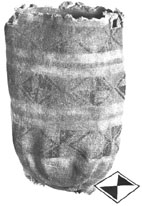
Mohegan Twined Bag
McMullen & Handsman 1987
The Narragansett twined bag dates to around 1675. The materials of this bag consist of corn husk and red wool around a basswood bark warp. The red wool, now largely disintegrated, may have filled most of the open work (Simmons 1978: 192). In contrast to the open bottom construction employed with the Mohegan bag, the Narragansett bag appears to have been woven by starting with a series of radiating warps, resembling a star, where twining begins at the center and works its way up the basket until the desired height is reached.
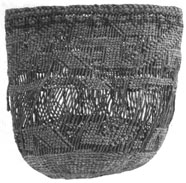
Narragansett Twined Bag
Simmons 1978
Because the Narragansett basket employs these different weaving techniques, there are some dissimilarities with the Mohegan bag. Most notably the form and the rim on the Narragansett bag differ from that of the Mohegan bag. However, and the Narragansett bag is similarly divided into a series of concentric bands, which are filled with geometric shapes consisting of triangles, squares, and zig-zags. Despite the differences in construction and materials of the bag, the design elements are strikingly similar to that of the Mohegan bag.
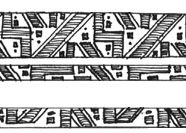
Reconstructed design of
Narragansett bag
by Prindle 2000
Handsman and McMullen (1978: 22) illustrate two splint basket fragments from two later 17th century seneca sites (1640-1660) in western New York which provide some of the earliest known evidence of splint production in northeastern North America. Handsman and McMullen (1978: 22) note the fragments were once part of small bowl-shaped baskets (one twill-woven) which may have once sifted ground corn. Turnbaugh and Turnbaugh (1986: 114) agree with Speck, Brasser and McMullen that Native Americans probably acquired the practice of producing checker-weave wood splint baskets from European immigrants. "The technology quickly became popular and began to supplant the stitching of birchbark and other presumably earlier aboriginal technologies probably only as recently as the 18th and 19th centuries" (Turnbaugh and Turnbaugh 1986: 114).
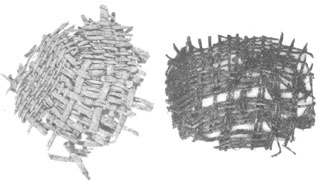
Seneca Basket Fragments
dating to the late 1600s
Handsman & McMullen 1978
Historians against the Native American origins of splint basketry argue that most of the tools used in splint basket production appear to be of European origin and have no early historic analog. Spoke-shaves, hand gauges, hand planers and the crooked knife all employ metal blades. The crooked type knife was used by Mohegans for woodworking in general Speck (1915: 3). Speck (1976: 37) illustrates several crooked knives. By 1610 the crooked knife employed a metal blade (sometimes curved) similar to a farrier's knife (Snow 1980: 58-59), suggesting European origin. Simmons (1970: 109) illustrates iron crooked knife blades found with Narragansetts buried at the 17th century West Ferry cemetery. However, Speck (1976: 106) also describes an aboriginal prototype of the crooked knife with a blade of beaver incisors set in the handle. Beaver incisors which may have been hafted into a bone, antler, or wooden handle have been found at archaeological sites of late prehistoric villages and an example of which is illustrated and discussed by Snow (1980: 338).

Passamaquoddy crooked knife
Erickson 1978
Skinner suggests it is very likely that the plaited, black-ash splint baskets were a relatively recent development (in Ritzenthaler & Ritzenthaler 1970: 79-80). Notwithstanding potential development from contact with Europeans in the early 17th century, Native splint basketry preserves several more traditional forms of ornamentation and embellishment, including designs for block stamping and the 'curlicue' (porcupine-twist) embellishment used on splint basketry.
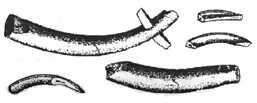
Penobscot
Hafted Beaver Incisors
Crooked knife Prototypes
Snow 1980
On Mahican baskets examined by Speck (1947: 12), potato stamp designs utilized among Pequot, Mohegan Schagticoke, and other Native Americans of southern New England, showed a great deal of correspondence and similarity to basket decoration of the Algonquin of Quebec which were collected between 1750 and 1790. These may be accepted as being the oldest dated examples of this form of potato-stamp decoration on the records (Speck 1947: 12). Speck (1947: 33) suggests that missionary influence and the printed text of the Bible in the 1600's, were in part responsible for the use of block-stamp decoration on baskets:
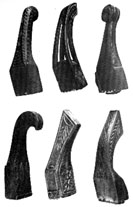
Penobscot
Splint guages
Speck 1976
BIBLIOGRAPHY
Anonymous
Church, Colonel Benjamin
Coe, Ralph T.
de Rasieres, Isaack
de Vries, David P.
Erikson, Vincent O.
Gookin, Daniel
Handsman, Russell G. and Ann McMullen
Heath, Dwight B., ed.
Lindholdt, Paul, ed.
Ritzenthaler, Robert E. and Pat Ritzenthaler
Salwen, Bert
Simmons, William S.
Snow, Dean R.
Speck, Frank G.
Turnbaugh, William A. and Sarah P. Turnbaugh
Williams, Roger
Wood, William
1967 "Representation of New Netherland" [1650]. In Narratives of New Netherland,
1609-1664. F.J. Jameson, ed. Pp. 285-354. New York: Barnes and Noble.
1975 Diary of King Philip's War 1675-1676. Introduction by Alan and Mary
Simpson. Published for the Little Compton Historical Society; Tiverton, RI:
Lockwood Publications.
1986 Lost and Found Traditions, Native American Art 1965-1985. New York:
University of Washington Press in Association with the American Federation
of Arts.
1967 Letter to Samuel Blommaert [1628 ?]. In Narratives of New Netherland,
1609-1664. F.J. Jameson, ed. Pp. 97-116. New York: Barnes and Noble.
1967 "Korte Historiale end Journaels Aenteyckeninge" [1633-1643 (1655)]. In
Narratives of New Netherland, 1609-1664. F.J. Jameson, ed. Pp. 181-234.
New York: Barnes and Noble.
1978 Maliseet-Passamaquoddy. In Northeast. B.G. Trigger, ed. Pp. 123-136.
Handbook of North American Indians, Vol. 15. W. Sturtevant, gen. ed.
Washington, D.C.: Smithsonian Institution.
1970 Historical Collections of the Indians in New England. J.H. Fiske, ed. London:
Towaid. (First published 1674).
1978 "An Introduction to Woodsplint Basketry and Its Interpretation." In A Key Into
the Language of Woodsplint Baskets. Ann McMullen and R.G. Handsman,
ed.s. Pp. 16-35. Washington, CT: American Indian Archaeological Institute.
1986 Mourt's Relation: A Journal of the Pilgrims at Plymouth. Cambridge:
Applewood books. (First published in 1622).
1988 John Josselyn, A Critical Edition of Two Voyages to New England. Hannover:
University Press of New England. (First printed in 1674).
1970 The Woodland Indians of the Western Great Lakes. Garden City, NY: Natural
History Press.
1978 Indians of Southern New England and Long Island: Early Period. In Northeast.
B.G. Trigger, ed. Pp. 160-169. Handbook of North American Indians, Vol.
15. W. Sturtevant, gen. ed. Washington, D.C.: Smithsonian Institution.
1970 Cautantowwit's House: An Indian Burial Ground on the Island of Conanicut in Narragansett Bay. Providence, RI: Brown University Press.
1978 Narragansett. In Northeast. B.G. Trigger, ed. Pp. 190-197. Handbook of
North American Indians, Vol. 15. W. Sturtevant, gen. ed. Washington, D.C.:
Smithsonian Institution.
1980 The Archaeology of New England. New York: Academic Press.
1915 Decorative Art of Indian Tribes of Connecticut. Anthropological series 10.
Memoirs of the Canadian Geological Survey 75. Ottawa, Ont: Canadian
Department of Mines.
1947 Eastern Algonkian Block-Stamp Decoration: A New World Original or an
Acculturated Art. Addendum by Eva Butler. Trenton: Archaeological Society
of New Jersey.
1976 Penobscot Man,: The Life History of a Forest Tribe in Maine. New York:
Octagon Books.
1986 Indian Baskets. West Chester PA: Schiffer Publishing Company.
1973 A Key into the Language of America. J.J. Teunissen and E.J. Hinz, ed.s.
Detroit: Wayne State University Press. (First printed 1643).
1865 Wood's New England's Prospect. Boston: Publications of the Prince
Society 1. (First published 1634).

© 1994-2000 Tara Prindle.